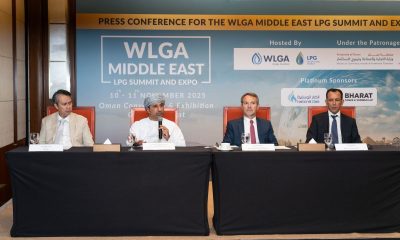Oman 2015
OiL PRODUCTION ON A HIGH
Although crude oil prices have been showing a sluggish trend, the country recorded a 3.2 per cent rise in oil production for the first eight months of 2015.

Although crude oil prices have been showing a sluggish trend, the country recorded a 3.2 per cent rise in oil production for the first eight months of 2015.
QUICK GLANCE
Iranian gas is expected to flow to Sohar two-and-a-half years down the line through a 260-km pipeline.
The foreign direct investment into Oman will get a shot-in-the-arm once the Sultanate could get additional natural gas.
An additional one billion cubic feet of gas is expected from BP’s Khazzan tight gas project by 2018.
Oman’s average daily crude oil production crossed one million barrels-mark in July month for the first time.
Petroleum Development Oman (PDO) is planning for a new sustainable long-term production of 600,000 bpd by 2019.
Oman’s ambitious plan to import huge volumes of natural gas from Iran is gathering momentum with the recent signing of agreements for conducting studies on laying a sub-sea pipeline linking both countries. Two agreements have been signed recently with private firms for the studies related to the pipeline on both offshore and onshore segments, which are a part of a deal to import 10 million cubic meters of natural gas from neighbouring Iran. The agreement for the offshore segment was signed with Iranian Offshore Engineering and Construction Company, while the onshore segment study will be conducted by Pars Engineering Company. The natural gas import, expected within two-and-a-half years, is part of a deal worth $60 billion worth natural gas sale over a 25-year period.
This will give the much-needed impetus to the country’s ambitious plans to strengthen its industrial base, using natural gas as feedstock as several gas-based industries are waiting for government commitment on additional gas for expansion. With Iranian gas expected to flow to Sohar two-and-a-half years down the line through a 260-km pipeline, the energy-hungry Oman is in a better position to commit the feedstock for expansion programmes of industries, which, in turn, will boost non-oil exports and diversification programme.
In fact, domestic gas requirements are set to expand rapidly over the next few years as the utilities sector grows to keep pace with rising demand for water and electricity, besides growth in industrial sector. The country’s major gas-based energy intensive industries, including Vale Oman Pelletizing Company, Jindal Shadeed Iron and Steel and Oman India Fertiliser Company, have all been ready with their master plans for massive capacity expansion programmes for more than two years, but have been waiting for a firm commitment from the government on additional natural gas as feedstock. Apart from the industries, the demand for natural gas is being driven by power projects and liquefied natural gas plants. It is generally believed that the foreign direct investment into Oman, especially in Sohar and Duqm, will get a shot-in-the-arm once the Sultanate could get additional natural gas as cheap natural gas for feeding industries is one of the major attractions for foreign investors.
The Sultanate was the first country in the region to take an early lead for taking economic advantage from lifting of trade sanctions on its neighbour. Iran sits on the world’s largest gas reserves, but it has been prevented from exporting much of it because of western sanctions.
Although the Sultanate has been trying for years to import gas from Iran, the detailed terms and a concrete agreement for importing gas was signed only in March last year, when Iranian president Hassan Rouhani visited the Sultanate along with a high-powered delegation. The gas will be transported through a long pipeline between Iran’s Ku-e Mubarak and Sohar port. The Sultanate will pay for the entire cost of the pipeline and related infrastructure, which is $1 billion, and it will be compensated over a period of time through revenues generated from the sale of gas.
The ongoing project of British energy giant BP is also gathering momentum with the company drilling dozens of new gas wells and building a $1.2 billion-worth central gas processing station. Contracts worth billions of dollars have been awarded in the last two years for building gas wells, central gas processing station and gathering pipelines. An additional one billion cubic feet of gas is expected from BP’s Khazzan tight gas project by 2018, which is another big boost to the supplies. Oman government and BP two years ago signed a major gas sales agreement and a production sharing pact for developing the Khazzan tight gas field with an estimated investment of $16 billion.
The full field development of Block 61 involves drilling programme of around 300 wells over 15 years to deliver plateau production of one billion cubic feet of gas per day and 25,000 barrels per day of gas condensate. This volume is equivalent to around a third of Oman’s total daily domestic gas supply and will significantly contribute to ensure continuous and stable supplies from domestic sources. BP owns 60 per cent of the venture and Oman Oil holds the rest 40 per cent.
The Khazzan project represents the first phase in the development of one of the Middle East region’s largest unconventional tight gas accumulations, which has the potential to be a major new source of gas supply for Oman over many decades.
The exploration and production sharing agreement and a gas sales agreement for an initial 30 years also provide for an additional appraisal of further gas resources within Block 61, which are expected to be developed in the subsequent phases of the project. The full-field development involves a 15-year drilling programme, with production tied back to a new central processing facility in Block 61 via a 500km long gathering system.
Meanwhile, the Sultanate’s natural gas production and imports rose 5.2 per cent to 22,666 million cubic metres (MNCM) for the first seven months of 2015, from 21,554 MNCM for the same period last year. While non-associated gas showed a growth of 6.5 per cent to 18,671 MNCM, associated gas production declined 0.6 per cent to 3,995MNCM, according to statistics released by the National Centre for Statistics and Information (NCSI).
A sizeable chunk of the natural gas in Oman is used by various mega industrial projects, which stood at 12,559MNCM for the first seven months of 2015, against 12,018MNCM for the same period last year. Natural gas is also used in oilfields either as fuel or for re-injection. Other major consumers of natural gas in the country include power producers, small-scale industries and liquefied natural gas plants.
The Sultanate’s natural gas production this year is projected at 120 million cubic metres per day, which is 15 million cubic metres higher than that of last year. Oman produced and imported 37,687 million cubic metres of natural gas last year (equivalent to 105 million cubic metres per day).
In fact, the country is rescheduling some of its liquefied natural gas (LNG) exports as rising domestic demand for power generation causes gas shortages that are hurting its industry. Nearly all of Oman’s gas exports go to Japan, South Korea and Spain. Some gas originally due to be delivered this year would be supplied in coming years. Five to 10 per cent of planned exports were rescheduled this year because of the gas shortage.
Spare production capacity at Oman LNG, which operates the country’s facilities for liquefying gas for export, last year reached its highest level since 2006. Oman produced 7.95 million tonnes of the fuel in 2014 from plants with an annual capacity of 10.4 million metric tonnes. Preliminary talks on importing liquefied natural gas to meet surging domestic energy demand are also going on within the ministry circles. LNG imports would supplement Oman’s current supply of natural gas by pipeline from Qatar. However, no concrete decision has been taken so far.
CRUDE PRODUCTION SURGES AHEAD
Oman government’s major effort to raise crude oil production with heavy investment started bearing fruits. Although crude oil prices have been showing a sluggish trend, the country recorded a 3.2 per cent rise in oil production for the first eight months of 2015 at 237.36 million barrels, compared with 230 million barrels in the same period last year. In other words, the daily average production for the January–August period of 2015 stood at 976,800 barrels per day (bpd), against 946,600 bpd in the same period of 2014. The daily average could touch 980,000 barrels per day for the entire year.
However, the price of Oman Crude averaged $60.2 per barrel for the first eight months of 2015, down 43 per cent from $105.7 per barrel registered for the same period of last year. The country has been trying to raise output and exports to partially offset its revenue loss in view of a dip in oil prices. In first eight months of 2015, Oman’s total oil exports (in terms of volume) rose 4.7 per cent to 205.97 million barrels from 196.75 million barrels a year earlier. Also, the Sultanate’s average daily crude oil production crossed one million barrels-mark in July month for the first time.
Crude oil production of majority state-owned Petroleum Development Oman (PDO) alone increased by 4 per cent to 570,534 barrels per day last year, thanks to aggressive drilling and new discoveries. PDO produced 550,000 barrels per day of crude oil in 2013 and last year’s output represented the highest production of the company since 2006.
The national oil company is planning to keep its production maintained at the current level until 2019 to a new sustainable long-term production of 600,000 bpd by 2019. The company’s enhanced oil recovery (EOR) projects, which were developed with huge investments in different oil fields, are contributing immensely to the overall production.
However, in view of sluggish trend in oil prices, oil producers in Oman, including majority state-owned Petroleum Development Oman (PDO), are resorting to cost cutting measures.
Major producers like PDO and Occidental have gone back to their contractors for identifying areas of cost cutting and for improving operational efficiencies.
Further, few energy global giants, which entered the country within the last few years, have either pulled out of Oman’s oil and gas blocks or scaled down their investment plans in view of slackness in oil prices. For instance, Norwegian oil and gas operator DNO International recently said that it has pulled out of two oil and gas blocks in the Sultanate. The company said in its second quarter earnings report that it had withdrawn from Block 30 and Block 31 in north-western part of Oman. With its departure from the two concessions, DNO has seen its portfolio of Omani hydrocarbon assets shrink to two blocks: Block 8 offshore Oman, and Block 36 onshore Oman. In addition, Singapore-based Rex International Holding Ltd said that it plans to reduce capital investments and focus on key discovery assets in Oman to preserve cash due to the downturn in oil prices. The company has moderated its drilling plans and operations budget to concentrate on assets in Oman.
Earlier, few other companies, French oil and gas giant Total has pulled out of a deepwater block in offshore Oman, after failing to make commercially viable discoveries. The company signed an exploration and production-sharing agreement in December 2013 for Block 41, which lies off the Omani coast northwest of Muscat and covers almost 24,000 square kilometres of seabed with depths of up to 3,000 metres. Last year Hungarian oil group MOL had pulled out from Block 34, and Norwegian oil firm DNO from Block 31. The Sultanate’s government has been making continuous efforts to encourage local and foreign investors to invest in oil and gas projects, such as exploration, production, refining, setting up gas-based industries and setting up downstream industries. Oman government has recently signed a new exploration and production sharing agreement with Oman Lasso Exploration and Production Karwan. The company will explore oil and natural gas in Block 54, which has an area of 5,632 square kilometres and located in Al Wusta Governorate. The agreement allows the company to drill several wells and the government does not bear any financial commitments during exploration period.
Presently, multinational oil companies contribute 30 per cent of total crude production, while PDO constitutes the remaining 70 per cent oil output. Among the foreign companies, Occidental Oman and its joint venture firms are leading producers of hydrocarbon resources in the country. As huge investment is required for bringing oil above the ground in view of the peculiar nature of reservoirs in Oman, the government has been encouraging multinational firms to undertake exploration on production sharing basis. But the recent fall in oil prices is a major setback for the government in attracting foreign investment.
-

 Alamaliktistaad Magazines2 months ago
Alamaliktistaad Magazines2 months agoAlam Al Iktisaad – September 2025 Edition
-

 News2 months ago
News2 months agoKitchenomiKs Secures Investment of US$3.2M Led by Jasoor Ventures
-

 Banking & Finance2 months ago
Banking & Finance2 months agoOman Arab Bank Highlights Its Ongoing Strategic Initiatives and Future Plans
-

 News2 months ago
News2 months agoIEA Expects Global Oil Market to Remain Oversupplied in 2026
-

 Energy2 months ago
Energy2 months agoWLGA Middle East LPG Summit & Expo 2025 to be held at OCEC on November 10 and 11
-

 Real Estate2 months ago
Real Estate2 months agoAl Mouj Muscat Unveils Azura Beach Residences Phase 2: A New Chapter in Waterfront Living
-

 Leaders Speak1 month ago
Leaders Speak1 month agoDhofar International Development and Investment Company: Driving Sustainable Growth and Strategic Synergies in Oman’s Investment Landscape
-

 Events1 month ago
Events1 month agoOER Corporate Excellence Awards 2025 Honours Entities and Innovations in Oman































You must be logged in to post a comment Login